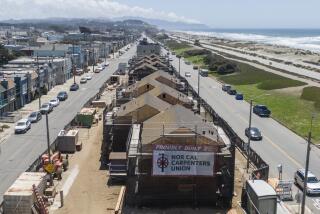No Sign of a Housing Bubble, Study Says
- Share via
There is no bubble in U.S. home prices despite the price surge in recent years, the New York Federal Reserve Bank said Tuesday, and even if regional prices do fall, that will not pose a threat to the overall economy.
The recent increase in house prices has been in line with declining mortgage rates, a factor that many arguments about a housing bubble ignore, the New York Fed said in a study.
“Our analysis of the U.S. housing market in recent years finds little evidence to support the existence of a national home price bubble,” Senior Economist Jonathan McCarthy and Vice President Richard Peach said.
The study has important implications for Federal Reserve policy because evidence of housing bubbles in both Britain and Australia has influenced their central banks to raise interest rates in the last year to cool the market.
Though the Federal Reserve is widely expected to start raising its benchmark rate at a policy meeting next week, officials have said they want to get the 1.0% federal funds rate back up to levels more consistent with a strong economy and are not targeting housing prices.
Central bank figures show that households hold about $14.6 trillion in real estate, or one-third more than the U.S. gross domestic product.
Some economists worry that the run-up in housing prices has created a bubble similar to the stock market excesses of the late 1990s and could jeopardize the economy if prices fall sharply.
Official figures show that average U.S. home prices rose 7.7% in the first quarter from a year earlier, but that masks sharp regional differences. In Southern California, prices are up 26.9% from a year ago.
The New York Fed study said although house prices have risen strongly, increases in family income and low mortgage rates have meant that homes remained affordable, while demographic forces have also supported demand.
The average mortgage rate has fallen from just over 10% in 1990 to about 5.75% in 2003. The Fed slashed official rates 13 times from January 2001 to June 2003.
“The most widely cited evidence of a bubble is not persuasive because it fails to account for developments in the housing market over the past decade,” the economists said in a forthcoming study entitled “Are Home Prices the Next ‘Bubble’?”
In addition, most house price indexes fail to account for the renovations, extensions and home improvements that contribute to higher prices, Peach said.
More to Read
Inside the business of entertainment
The Wide Shot brings you news, analysis and insights on everything from streaming wars to production — and what it all means for the future.
You may occasionally receive promotional content from the Los Angeles Times.










